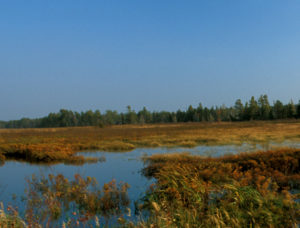
Great Lakes coastal wetland via FWS
Lakeshore marshes and meadows create wildlife habitat and provide benefits to people, too …
Howe: “Filtering your water, absorbing high water during flooding events, providing more fish and wildlife experiences for people.”
Jim Howe directs the Nature Conservancy of Central and Western New York. He says maintaining these ecosystems requires occasional fluctuations in water level. High water keeps woody plants from encroaching on meadow, and low water allows seeds in the lake bed to germinate.
For decades, water levels on Lake Ontario have been tightly controlled. But now, a new plan will allow lake water to rise and fall more naturally, replenishing 64,000 acres of wetland.
Get Schooled:
- Check out where Great Lakes coastal wetlands are, on this EPA site.
- Learn more about the Nature Conservancy’s work to protect wetlands across the Great Lakes Basin.
- Learn more about Plan 2014 from the IJC.
The fine print:
- This segment was produced in partnership with Cornell University’s Atkinson Center for a Sustainable Future




